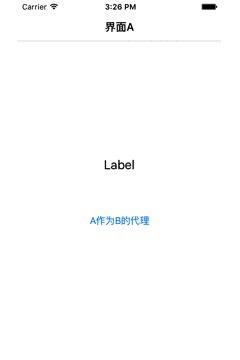iOS 代理反向傳值
編輯:IOS技巧綜合
在上篇博客 iOS代理協議 中,側重解析了委托代理協議的概念等,本文將側重於它們在開發中的應用。
假如我們有一個需求如下:界面A上面有一個button、一個label。從界面A跳轉到界面B,在界面B的輸入框中輸入字符串,在界面A的label上顯示。這是一個典型的反向傳值的例子。這個例子的核心是:“在界面B的輸入框中輸入字符串,在界面A的label上顯示”。也就是說:“界面B委托界面A顯示字符串,頁面A是界面B的代理”。委托方向代理方反向傳值。
那麼我們該怎麼用代理設計模式來實現這個需求呢?
在程序中:
1.委托需要做的工作有:
1.1定義協議與方法
1.2聲明委托變量
1.3設置代理
1.4通過委托變量調用委托方法
2.代理需要做的工作有:
2.1遵循協議
2.2實現委托方法
在BViewController.h中:
//定義協議與方法 @protocol DeliverDetegate <NSObject> - (void)setValue:(NSString *)string; @end @interface BViewController : UIViewController //聲明委托變量 @property (weak,nonatomic) id<DeliverDetegate>B_Delegate; @end
在BViewController.m中:
@interface BViewController ()<UITextFieldDelegate> @property (strong, nonatomic) IBOutlet UITextField *DeliverText; @end
- (IBAction)DeliverAction:(id)sender {
//通過委托變量調用委托方法
//輸入則顯示輸入的字符串,未輸入顯示“未填寫”
if (![_DeliverText.text isEqualToString:@""]) {
NSLog(@"B向A發送數據%@",_DeliverText.text);
//判斷代理中的方法是否被實現,避免未被實現代理的程序崩潰
if ([self.B_Delegate respondsToSelector:@selector(setValue:)])
{
[self.B_Delegate setValue:_DeliverText.text];
}
}
else
{
NSLog(@"B向A發送數據%@",@"未填寫");
//判斷代理中的方法是否被實現,避免未被實現代理的程序崩潰
if ([self.B_Delegate respondsToSelector:@selector(setValue:)])
{
[self.B_Delegate setValue:@"未填寫"];
}
}
[self.navigationController popViewControllerAnimated:YES];
}
在AViewController.m中
#import "AViewController.h" #import "BViewController.h" @interface AViewController ()<DeliverDetegate> @property (strong, nonatomic) IBOutlet UILabel *TextLabel; @end
- (IBAction)ReceiveAction:(id)sender {
//遵循協議
BViewController*BVC = [[BViewController alloc]init];
BVC.B_Delegate = self;
[self.navigationController pushViewController:BVC animated:YES];
}//實現委托方法,即實現的setValue方法
- (void)setValue:(NSString *)string
{
NSLog(@"A接收到B數據%@",string);
_TextLabel.text = string;
}
最後的效果圖如下:

輸出日志:

- 上一頁:基於AFNetworking3.0的網絡封裝
- 下一頁:UI中的七種手勢
相關文章
+



